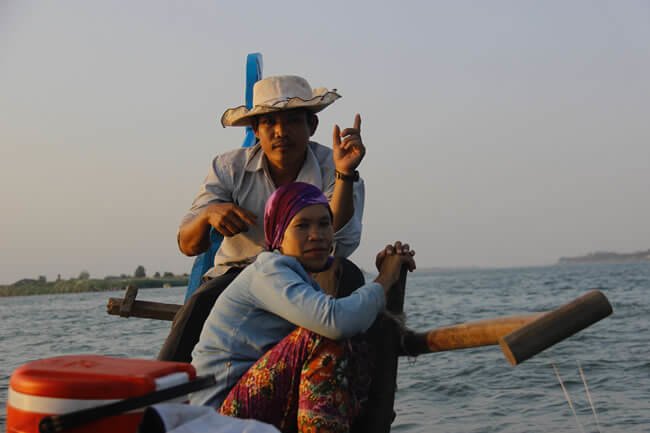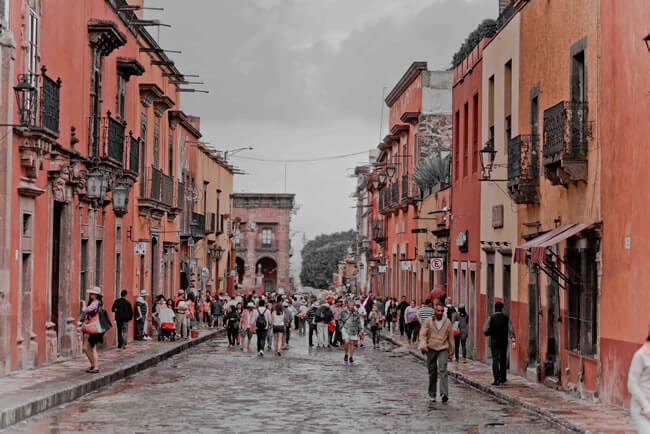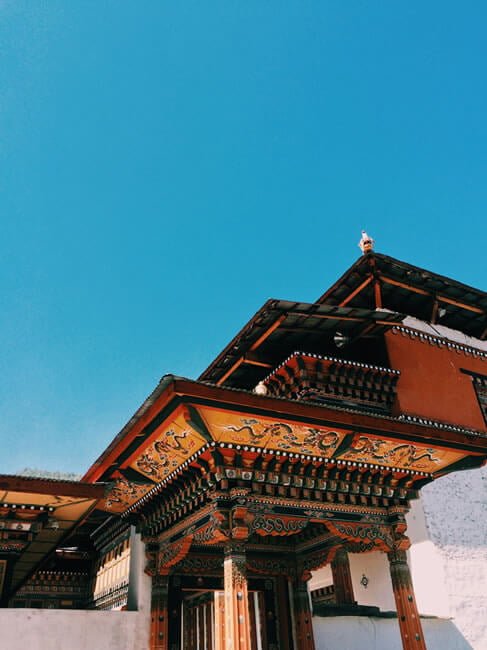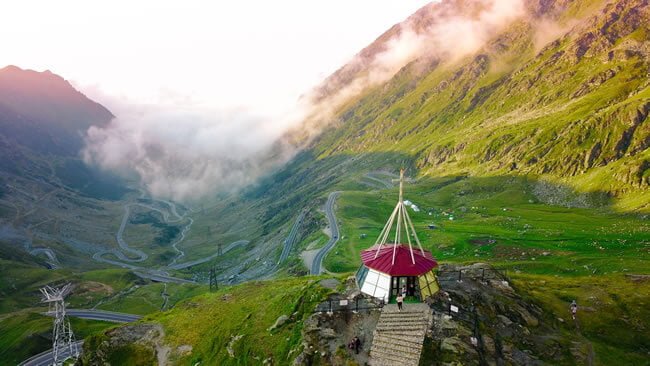National Geographic Traveller (UK) reveals The Cool List: 19 must-see destinations for 2019
National Geographic Traveller (UK) has announced its Cool List 2019, highlighting the 19 must-see destinations for the year ahead. The hotly anticipated list of countries and cities is revealed in the Jan/Feb 2019 issue of the magazine — on sale on Thursday 6 December.
Pat Riddell, editor of National Geographic Traveller, said: “Our team of editors, writers and industry experts have compiled the 19 destinations set to hit the headlines, with key openings, new routes and rising-star destinations firmly in the spotlight.”
“The Cool List 2019 includes stellar destinations such as Pittsburgh and Guyana — now within easy reach, thanks to new flights — not to mention Eritrea, finally open to tourists after decades off-limits, and the buzzing arts scene of locations as wide-ranging as Hong Kong and West Yorkshire.”
The Cool List 2019
1. Setouchi
2. Antarctica
3. Pittsburgh
4. Corsica
5. Cambodia
6. San Miguel de Allende
7. West Yorkshire
8. Hong Kong
9. Zimbabwe
10. Guyana
11. Oslo
12. Eritrea
13. KwaZulu-Natal
14. Bhutan
15. Dundee
16. Uganda
17. Matera
18. Indonesia
19. Sibiu
1. Setouchi
Why now? Japan is to host the 2019 Rugby World Cup, and for those looking to avoid the crowds in Tokyo or Osaka, Japan’s Inland Sea is the ideal low-key getaway.
Main attractions: England, Scotland and Ireland will all play at Kobe Misaki Stadium, and there’s plenty to do once the final whistle goes. Visit cities such as Hiroshima, or Matsuyama, or island-hop on the Inland Sea. Naoshima (Japan’s ‘art island’) has Chichu Art Museum, with works by Monet, James Turrell and Walter De Maria, as well as Yayoi Kusama’s polka-dot pumpkin sculptures. In 2019, it joins 12 other islands and two ports in hosting the Setouchi Triennale art festival.
2. Antarctica
Why now? Two-hundred years ago, Englishman William Smith discovered Antarctica, and a tall ship expedition is being launched to mark the anniversary.
Main attractions: In 1819, William Smith sighted what became known as Livingston Island, part of the South Shetlands archipelago, just off the Antarctic mainland. And this year a replica of his tall ship, The Williams, will make the same journey. The Williams II, a refitted oak vessel constructed in 1914 that matches the dimensions of Smith’s craft, will make a voyage around Britain in spring, ahead of the Antarctic trip. You can apply to join the crew on one of its 10 week-long stages; no experience is necessary.
3. Pittsburgh
Why now? On 2 April, British Airways launches direct flights from Heathrow to Pittsburgh, making this underrated Pennsylvanian city much easier to visit.
Main attractions: While Pittsburgh is a blue-collar town at heart, it’s much more elegant than many visitors might expect. And there’s plenty for culture vultures, too. In 2019, the Heinz History Center plays host to an exhibition on the Apollo 11 Moon landings, while the Carnegie Museum of Art hosts the Carnegie International, the world’s oldest contemporary art exhibition, featuring the works of 30 artists from around the globe. The name most associated with Pittsburgh’s art scene, though, is local boy Andy Warhol, and the Warhol Museum features more than 8,000 works by the pop artist, plus an insight into his whirlwind life.
4. Corsica
Why now? Air Corsica recently began flying direct from the UK, and in summer 2019 British Airways will start serving Bastia and Figari, meaning this stunning island will be more accessible to Brits than ever.
Main attractions: The scenery, which shifts from white sandy beaches to soaring mountains, lush greenery and historic fortified towns. Explore single-track railways, swim beneath the 15th-century Citadel of Calvi, snack on figatelli sausages, or hike a stretch of the GR20 (a tough but beautiful 112-mile trail). Plus, with 2019 marking 250 years since the birth of Napoleon, it’s the perfect time to visit Maison Bonaparte, the emperor’s childhood home in Ajaccio.
5. Cambodia
Why now? This year’s batch of new high-end hotels make Cambodia even harder to resist.

Main attractions: Two new design-led, environmentally-aware island resorts are set to open: Alila Villas Koh Russey, a low-rise, modernist island escape spilling onto a private stretch of sands so soft it’s nigh-on impossible to leave footprints; and Six Senses Krabey Island, a secluded hideaway with seahorses bobbing in the water out front and Cambodian-inspired treatments in the spa. Alternatively, escape to the jungle for a stay at the recently opened Shinta Mani Wild, a luxury camp with tented suites perched above a river between three national parks.
6. San Miguel De Allende
Why now? This colonial-era Mexican city is the American Capital of Culture 2019.

Jezael Melgoza
Main attractions: Located in the Central Highlands, San Miguel de Allende is packed with history (it played a key role in the Mexican War of Independence in the early 19th century) with striking baroque buildings and cobbled alleys. However, the city is perhaps best known for a vibrant tradition of arts and culture, and in 2008 was designated a UNESCO World Heritage Site. The streets are dotted with studios, shops and galleries that are home to working artists and local craftspeople.
7. West Yorkshire
Why now? A major new sculpture triennial is set to open in the summer.
Main attractions: The Henry Moore Institute, Leeds Art Gallery, The Hepworth Wakefield and Yorkshire Sculpture Park have joined forces to stage the first Yorkshire Sculpture International, from June-September. The Hepworth Wakefield will also be unveiling its Hepworth Riverside Gallery Garden, with access to the former Victorian mill buildings next door. Elsewhere, the Calder Valley — with hippyish Hebden Bridge as its epicentre — is a burgeoning hub for restaurants and independent shops.
8. Hong Kong
Why now? A glut of arts attractions and transport links make Hong Kong a cultural hotspot in 2019.
Main attractions: Making waves on the Kowloon waterfront is Victoria Dockside; the best place for a harbourside stroll, with sculpture parks, art galleries and tai chi gardens. The West Kowloon Cultural District, meanwhile, is home to a new Cantonese opera house, the Xiqu Centre, and later in 2019 will be the location of M+ — a museum set in an inverted ‘T’ of steel; exhibits will include works by Ai Weiwei.
Back on Hong Kong Island, Tai Kwun, known as ‘the Big House’, is a former police station, prison and court that’s been converted into interactive galleries and some of the city’s hottest new bars and restaurants (try Old Bailey for divine dim sum).
9. Zimbabwe
Why now? With Mugabe gone, Zimbabwe’s new president, Emmerson Mnangagwa, seems keen to invest in tourism. And while there’s been economic and political turbulence, the safety of tourists hasn’t come into question.
Main attractions: Victoria Falls and the surrounding area have always enjoyed the lion’s share of the attention, and for good reason. As well as the beautiful falls themselves, the Zambezi flows through gorges and over rapids that are perfect for those after an adrenalin rush. And don’t miss Zambezi National Park, three miles away. Just 10 years ago, you’d have been lucky to see anything but a few impala here, but the local anti-poaching unit has made enormous strides and the species list now includes four of the Big Five (only the rhino is missing).
10. Guyana
Why now? More flight connections make reaching the country’s natural attractions even easier.
Main attractions: Hardly anyone goes to Guyana. With only around 3,500 tourists per year, almost 20 times as many go to Antarctica. The former British colony is technically one of three Guyanas — alongside Suriname and French Guiana — but despite being English-speaking and having direct flights from Miami (to which American Airlines added an extra flight in December) and New York, it’s never established itself as a tourist destination. Guyana’s main prize is Kaieteur Falls. The largest single-drop waterfall in the world is a beauty, cutting its way through the jungle as the Potaro River falls 741ft before continuing towards the Atlantic.
11. Oslo
Why now? Oslo is the European Green Capital for 2019 — a sweet marriage of sightseeing and sustainability. Main attractions: Sure, you need to see The Scream, Vigeland Sculpture Park and Oslo’s stunning Viking ships. But pair all of that with a taste of the future at Fjord City, a waterfront reboot crammed with forward-thinking museums, art venues, parks, work and living spaces. Join Green Capital guided walks or community dinners at Losæter urban farm, or stay at the upcoming Clarion Hotel The Hub — Norway’s largest, with 810 rooms, opening in March.
12. Eritrea
Why now? Having struck new peace agreements with neighbouring Ethiopia and Djibouti, this little-visited African country is opening up to adventurous travellers as well as those with an eye for architecture.
Main attractions: Eritrea is a former colony of Mussolini’s Italy and its capital, Asmara, is a treasure trove of mid-century modernist architecture, where espressos, mopeds and vintage Fiats are as common as mojitos and Cadillacs are in Havana. In 2017, UNESCO declared the entire city centre a World Heritage Site. Beyond Asmara, Eritrea has intriguing towns and wilderness regions to discover. The Red Sea is barely two hours away; from the port of Massawa you can visit the Dahlak Archipelago for superb diving. In July 2018, Ethiopian Airlines resumed its flights from Addis Ababa to Asmara for the first time in 20 years, meaning it’s now easy to visit both capitals in one trip.
13. KwaZulu-Natal
Why now? British Airways recently launched direct flights from Heathrow to Durban, plus two new lodges are opening in the Hluhluwe–Imfolozi Park.
Main attractions: The beaches stretching for miles either side of Durban make KZN a viable winter sun hotspot, but the real appeal is in the wildlife. Magical encounters with elephant herds and rescued rhinos in Hluhluwe-Imfolozi Park can be combined with nature cruises from St Lucia — the coastal town where wild hippos roam the streets.
14. Bhutan
Why now? This Himalayan kingdom is considered one of the ‘happiest’ places on the planet and, in 2019, a swirl of swish yet sustainable resorts will open.

Main attractions: Partly thanks to the fact it limits tourist numbers via an incredibly high tourist tax — up to $250 (£195) per person, per day — Bhutan has remained relatively insulated from the rest of the world. Ancient palaces and Buddhist monasteries cling to the sides of cliffs, tales of abominable snowmen, ghosts and angels abound, and that tourist tax goes towards infrastructure, education and healthcare for local people. In 2019 you’ll find half a dozen new resorts with a sustainable slant, including five mountain lodges from Six Senses, and what bills itself as the country’s first dedicated wellness retreat, Bhutan Spirit Sanctuary, high in the Neyphug Valley.
15. Dundee
Why now? Being chosen as the only city outside of London to house a V&A Museum has created a new kind of swagger for Dundonians — and there’s more transformation to come.
Main attractions: The £1bn redevelopment of the waterfront is still ongoing, but its crown jewel — the V&A, which opened in late-2018 — is in place. The project has also brought new restaurants, bars and a new railway station building to a part of town that had been in decline for decades. A few minutes’ walk away you’ll also find Robert Falcon Scott’s Antarctic exploration vessel, the RRS Discovery, which was built here in 1900.
16. Uganda
Why now? When Rwanda doubled the price of its gorilla trek permits from $750 to $1,500 (£572 to £1,144) in 2017, neighbouring Uganda responded by freezing its own rates at $600 (£458) until mid-2019.
Main attractions: If you’re longing to see mountain gorillas in the wild, but Rwanda’s ultra-luxe lodges and high permit fees don’t suit your budget, head for Uganda’s Bwindi Impenetrable Forest instead. The steady growth of its gorilla population is one of Africa’s great conservation success stories, with tourists playing an important role. Almost 20 families can now be visited by guided groups of up to eight. Trekking fees raise funds not only for gorillas and their habitat, but also for Uganda’s other national assets including Queen Elizabeth and Murchison Falls National Parks, home to chimps, giraffes and hippos.
17. Matera
Why now? If you need an excuse to visit the southern Italian clifftop city of Matera, its denomination as a 2019 European Capital of Culture is it.

Main attractions: The Sassi cave dwellings and churches carved into the mountains of this remote destination in Basilicata have made great locations for movie shoots over the years, but are still largely overlooked by tourists. More’s the pity. It’s a unique, atmospheric city where you can check into a hotel, dine in restaurants and visit artists’ workshops all set in ancient stone grottos that once housed some 15,000 people and their livestock, many of which lay abandoned for decades.
18. Indonesia
Why now? This October, it’s 150 years since Alfred Russel Wallace’s book The Malay Archipelago was published — the perfect time to sail the region.
Main attractions: Wallace’s answer to Darwin’s On the Origin of Species sets out pretty much all we now know about tropical flora and fauna and has never been out of print. Wallace spent 1854 to 1862 travelling the Malay Archipelago where he discovered the striking division in the distribution of animals that’s since become known as the Wallace Line: an invisible marker between Bali and Lombok running northward between Borneo and Sulawesi, either side of which the distinct fauna of Asia and Australasia are found. Several trips make the natural wonders of this region more accessible, including a new Dive Worldwide liveaboard experience tailored to snorkellers in the biodiverse Coral Triangle.
19. Sibiu
Why now? This attractive Romanian city is part of the 2019 European Region of Gastronomy.

Photo by Lorenzo Castagnone on Unsplash
Main attractions: Throughout the year there’ll be a programme of food festivals and events, markets and specialised tours focusing on the diversity of dishes from around Transylvania. However, Sibiu is worth visiting in its own right; a beautifully preserved 800-year-old walled city, it’s full of winding lanes, squares and grand churches, as well as the magnificent Brukenthal National Museum, which opened way back in 1817. Wizz Air offers easy access with direct flights to Sibiu from Luton.

19 must-see destinations for 2019
Source: APL Media








